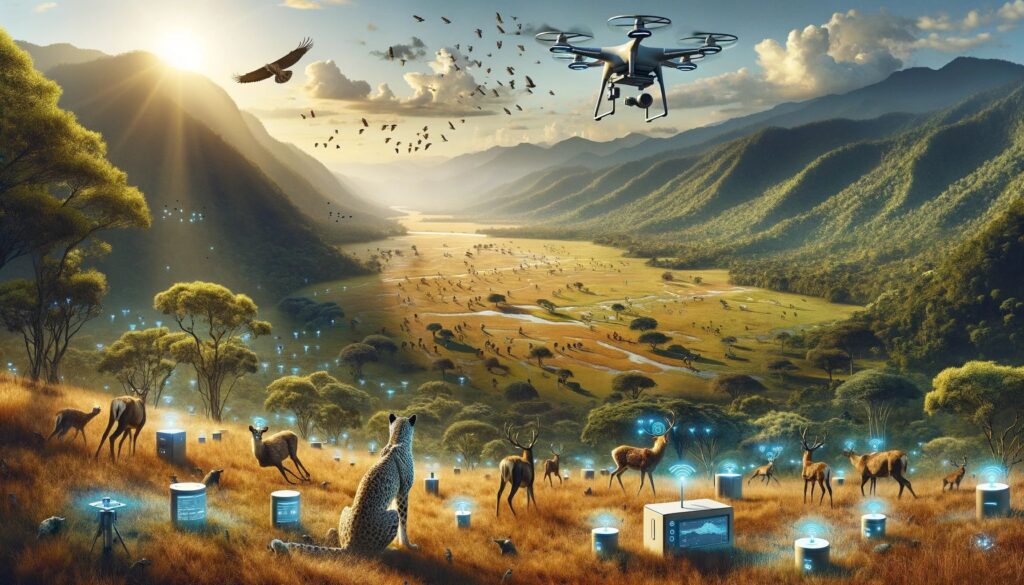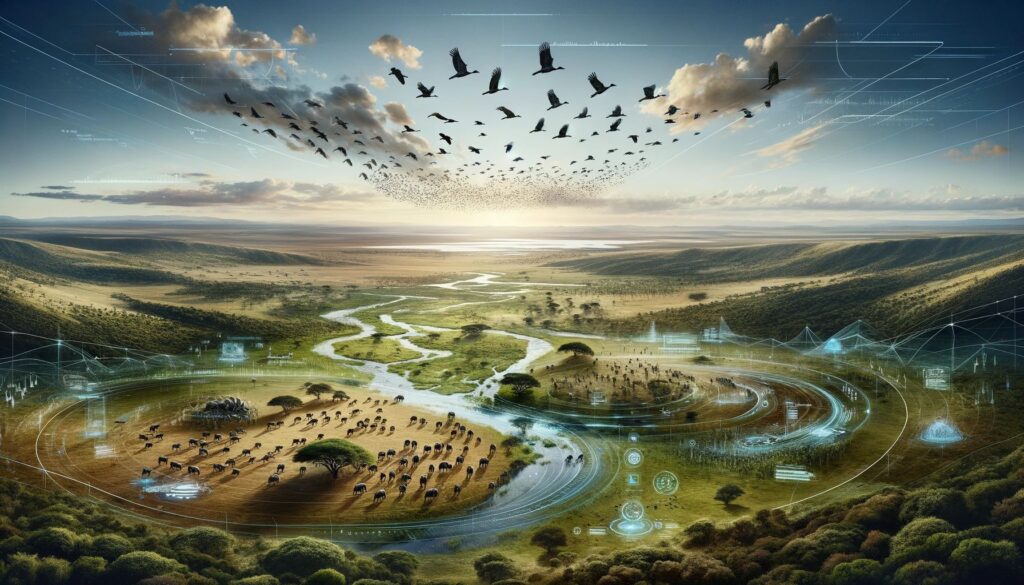The realm of wildlife conservation is witnessing a paradigm shift, thanks to the advent and integration of artificial intelligence (AI). Once reliant solely on manual observation and traditional methodologies, the field is now embracing AI’s prowess to tackle some of the most pressing challenges in preserving biodiversity. This seismic shift is not just about adopting new technologies; it’s a reimagining of conservation strategies in the digital age.
The Current State of Wildlife Conservation
Wildlife conservation efforts are crucial in maintaining biodiversity, ensuring ecosystem stability, and protecting species from extinction. However, these efforts face numerous challenges, including habitat loss, climate change, poaching, and insufficient funding for research and preservation initiatives. These obstacles often make conservation a daunting task. Traditional methods, while effective to a degree, are limited by human resources, time, and sometimes, accessibility to remote or dangerous locales.
The Advent of AI in Conservation
Enter AI, a suite of technologies that encompass machine learning, data analysis, and pattern recognition, among others. AI, with its ability to analyze vast amounts of data quickly and accurately, presents a revolutionary tool in the conservationist’s arsenal. It extends the reach and enhances the effectiveness of conservation efforts in several key areas:
- Data Processing and Analysis: AI algorithms excel in sifting through massive datasets – from satellite images to sensor data – identifying patterns and insights that would be nearly impossible for humans to discern manually.
- Species Monitoring and Identification: Camera traps and other remote monitoring devices generate an overwhelming amount of visual and acoustic data. AI helps in swiftly identifying species, counting individuals, and even recognizing specific animal behaviors from this data.
- Predictive Analytics: By analyzing trends and patterns, AI can predict potential threats to wildlife, such as identifying areas at higher risk of poaching or habitat destruction.
- Enhanced Field Research: AI tools can process environmental data to help researchers understand complex ecosystem dynamics, making field research more efficient and comprehensive.
Transforming Conservation Strategies
AI transforms wildlife conservation by enabling proactive threat identification and a global perspective on conservation strategies. Challenges include data privacy, ethical AI use, and the need for unbiased datasets. Collaboration among technologists, conservationists, and policymakers is essential for responsible and effective AI adoption in wildlife conservation.
AI-Powered Monitoring: A New Era in Wildlife Observation

The integration of AI in wildlife conservation has ushered in a new era of monitoring and observation. Utilizing advanced technologies, conservationists are now equipped to gather and analyze data with unprecedented precision and scale. This shift is predominantly visible in two key areas: the deployment of camera traps and the use of acoustic recordings.
Detailing the Use of Camera Traps and Acoustic Recordings
Camera Traps: These are motion-activated cameras installed in various habitats. They capture images or videos of wildlife without human presence, thereby reducing disturbance to the animals and providing a more accurate picture of their natural behaviors.
Acoustic Recordings: This involves the use of sophisticated audio equipment to record sounds within an ecosystem. These sounds can range from the calls of specific animal species to broader acoustic signatures of the environment. Acoustic monitoring is particularly useful for studying nocturnal or elusive species that are rarely seen but often heard.
How AI Interprets Complex Data to Monitor Wildlife
AI enhances wildlife conservation by automating data analysis, rapidly identifying species in camera trap images and animal calls in audio recordings. It can detect subtle environmental changes, revealing ecological shifts and emerging threats to wildlife. Analyzing this data provides insights into animal populations, movements, and health. AI-driven monitoring empowers conservationists with richer data, facilitating informed decisions, swift response to threats, and better conservation strategies. This technology goes beyond data collection, enabling deeper insights and more effective protection of the natural world.
Machine Learning in Species Identification and Behavior Analysis
The application of machine learning, a core component of artificial intelligence, has revolutionized the way species are identified and their behaviors analyzed. This technological advancement is pivotal in enhancing the accuracy and efficiency of wildlife monitoring and conservation efforts.
Exploring AI Algorithms in Identifying Species and Understanding Animal Behaviors
Machine learning algorithms are exceptionally adept at processing and interpreting visual and acoustic data from various sources, like camera traps and audio sensors. These algorithms are trained on vast datasets to recognize different animal species, even in challenging conditions such as poor lighting or obscured views. Additionally, they can analyze patterns in animal movements and behaviors, providing insights that were previously unattainable with manual analysis. For instance, AI can detect subtle changes in behavior that may indicate stress, illness, or changes in environmental conditions, offering crucial information for conservation strategies.
Successful Species Monitoring
- Great Ape Monitoring: AI and camera traps track elusive great apes for conservation.
- Birdsong Recognition: AI identifies bird songs, aiding bird population studies.
- Marine Conservation: AI analyzes underwater acoustics to protect marine life, including tracking endangered whales.
- Anti-Poaching: AI camera traps distinguish animal from human activity, aiding anti-poaching efforts.
- Desert Ecosystems: AI monitors arid region species often overlooked in conservation.
Tracking Migration and Ecosystem Changes with AI

Artificial Intelligence (AI) has become an indispensable tool in the study of animal migration patterns and the understanding of ecosystem changes. Its ability to process large datasets has provided conservationists with valuable insights that are critical for effective wildlife management and conservation strategies.
Discussing the Use of AI in Tracking Animal Migration Patterns
The migration patterns of animals are complex and influenced by a variety of ecological and environmental factors. AI, with its advanced data processing capabilities, excels in analyzing these patterns. By integrating data from GPS trackers, satellite imagery, and environmental sensors, AI algorithms can map migration routes with high precision. This information is vital for understanding the needs of migratory species, identifying critical habitats, and ensuring their protection. AI-enabled tracking also helps in predicting migration changes due to climate change, enabling proactive conservation measures.
How AI Helps in Understanding Ecosystem Changes
- Climate Impact Analysis: AI models analyze climate data to understand its impact on ecosystems, helping to predict shifts in habitats and biodiversity.
- Vegetation Monitoring: Using satellite imagery and remote sensing data, AI can detect changes in vegetation cover, which is a key indicator of ecosystem health and helps in identifying areas that require conservation attention.
- Water Resource Management: AI algorithms assess changes in water bodies, crucial for aquatic ecosystems and the species that depend on them, aiding in the management of these critical resources.
- Species Interaction Studies: By analyzing large datasets, AI helps in understanding the complex interactions between different species within an ecosystem, which is essential for maintaining ecological balance.
- Pollution Impact Assessment: AI tools are used to monitor and assess the impact of pollution on ecosystems, from analyzing air quality data to detecting chemical changes in water bodies.
Combatting Poaching: AI as a Crucial Tool
The fight against poaching, a major threat to wildlife conservation, has been significantly strengthened by the incorporation of artificial intelligence (AI). AI’s capabilities in data analysis and pattern recognition are proving to be pivotal in detecting and preventing illegal wildlife activities.
Examining AI’s Role in Detecting and Preventing Poaching Activities
AI’s application in anti-poaching efforts mainly revolves around its ability to analyze data from various sources, such as camera traps, motion sensors, and drones. These tools, when equipped with AI algorithms, can differentiate between normal wildlife movement and human activity, alerting authorities to potential poaching incidents in real-time. AI systems can also predict poaching hotspots by analyzing historical data, which helps in allocating resources more effectively. Additionally, AI-driven facial recognition technology is being used to identify known poachers, further bolstering surveillance efforts.
Highlighting Successful Anti-Poaching Initiatives Powered by AI
AI plays a pivotal role in safeguarding African elephants. It analyzes camera trap images to detect human presence near their habitats, enabling rapid anti-poaching responses. AI-powered drones provide real-time surveillance, enhancing patrol coverage. Additionally, AI monitors online platforms to combat illegal wildlife trade. These efforts highlight AI’s vital role in poaching prevention, contributing to biodiversity preservation and ecosystem health.
Collaborative Efforts: Integrating AI with Traditional Conservation Methods
The integration of artificial intelligence (AI) with traditional conservation methods is forging a powerful alliance in the fight to protect global biodiversity. This synergy amplifies the strengths of both approaches, leading to more effective and sustainable conservation efforts.
Discussing the Synergy Between AI and Traditional Conservation Practices
AI complements traditional conservation methods by processing and analyzing extensive data, revealing hidden insights. This synergy empowers conservationists to make informed decisions blending empirical knowledge with data-driven insights. Additionally, AI automates routine tasks, enabling researchers to focus on strategic aspects of conservation. This collaborative approach enhances efficiency and resource utilization, advancing wildlife and ecosystem preservation.
Examples of Collaborative Projects and Their Impacts
- Wildlife Corridor Planning: In several regions, conservationists are using AI to analyze habitat data, alongside traditional tracking methods, to identify and create wildlife corridors. These corridors are crucial for ensuring safe migration paths for animals, reducing human-wildlife conflict, and preserving biodiversity.
- Restoration Projects: AI is being used to analyze historical ecological data and current satellite imagery to guide restoration efforts. In projects like reforestation and wetland restoration, this approach ensures that efforts are strategically targeted and more likely to succeed.
- Community Engagement Initiatives: AI tools are employed to analyze social and economic data to understand the impact of conservation efforts on local communities. This integration ensures that conservation strategies are sustainable and beneficial both for wildlife and local populations.
- Endangered Species Recovery Programs: AI is augmenting recovery programs for endangered species by analyzing genetic data alongside traditional breeding and habitat management practices. This approach increases the chances of success for these critical programs.
Addressing the Challenges and Ethical Considerations of Using AI
- Data Privacy and Security: Ensuring the security of sensitive data, such as locations of endangered species, is paramount to prevent misuse or exploitation.
- Bias in AI Models: There’s a need to address potential biases in AI models to ensure they are effective across different ecosystems and species.
- Accessibility and Equity: It’s essential to ensure that AI technologies are accessible to conservationists around the world, not just in resource-rich countries.
- Ethical Use of AI: The development and deployment of AI in conservation must adhere to ethical standards, ensuring that the technology does not harm wildlife or ecosystems.
- Interdisciplinary Collaboration: Effective AI solutions require collaboration between technologists, ecologists, local communities, and policymakers.
- Long-term Sustainability: It’s important to consider the long-term sustainability of AI initiatives, including maintenance of technology and continuous training of personnel.
Conclusion
AI is revolutionizing wildlife conservation, improving data processing and ecological trend prediction. This technology enhances traditional methods and underscores the potential of AI as a force for positive change in preserving biodiversity. However, challenges like data privacy and ethics must be addressed to ensure equitable access and responsible use of AI. The future of conservation, driven by AI, aims for a sustainable, inclusive, and ethical framework, fostering harmony between technology and nature for a diverse and vibrant planet.




